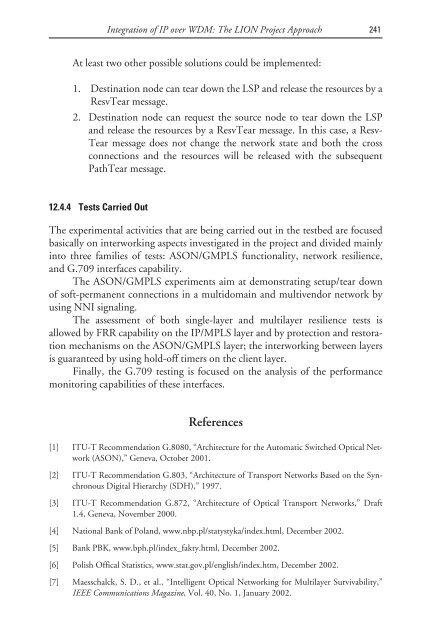deploying and managing ip over wdm networks - Index of
deploying and managing ip over wdm networks - Index of
deploying and managing ip over wdm networks - Index of
Create successful ePaper yourself
Turn your PDF publications into a flip-book with our unique Google optimized e-Paper software.
At least two other possible solutions could be implemented:<br />
1. Destination node can tear down the LSP <strong>and</strong> release the resources by a<br />
ResvTear message.<br />
2. Destination node can request the source node to tear down the LSP<br />
<strong>and</strong> release the resources by a ResvTear message. In this case, a Resv-<br />
Tear message does not change the network state <strong>and</strong> both the cross<br />
connections <strong>and</strong> the resources will be released with the subsequent<br />
PathTear message.<br />
12.4.4 Tests Carried Out<br />
Integration <strong>of</strong> IP <strong>over</strong> WDM: The LION Project Approach 241<br />
The experimental activities that are being carried out in the testbed are focused<br />
basically on interworking aspects investigated in the project <strong>and</strong> divided mainly<br />
into three families <strong>of</strong> tests: ASON/GMPLS functionality, network resilience,<br />
<strong>and</strong> G.709 interfaces capability.<br />
The ASON/GMPLS experiments aim at demonstrating setup/tear down<br />
<strong>of</strong> s<strong>of</strong>t-permanent connections in a multidomain <strong>and</strong> multivendor network by<br />
using NNI signaling.<br />
The assessment <strong>of</strong> both single-layer <strong>and</strong> multilayer resilience tests is<br />
allowed by FRR capability on the IP/MPLS layer <strong>and</strong> by protection <strong>and</strong> restoration<br />
mechanisms on the ASON/GMPLS layer; the interworking between layers<br />
is guaranteed by using hold-<strong>of</strong>f timers on the client layer.<br />
Finally, the G.709 testing is focused on the analysis <strong>of</strong> the performance<br />
monitoring capabilities <strong>of</strong> these interfaces.<br />
References<br />
[1] ITU-T Recommendation G.8080, “Architecture for the Automatic Switched Optical Network<br />
(ASON),” Geneva, October 2001.<br />
[2] ITU-T Recommendation G.803, “Architecture <strong>of</strong> Transport Networks Based on the Synchronous<br />
Digital Hierarchy (SDH),” 1997.<br />
[3] ITU-T Recommendation G.872, “Architecture <strong>of</strong> Optical Transport Networks,” Draft<br />
1.4, Geneva, November 2000.<br />
[4] National Bank <strong>of</strong> Pol<strong>and</strong>, www.nbp.pl/statystyka/index.html, December 2002.<br />
[5] Bank PBK, www.bph.pl/index_fakty.html, December 2002.<br />
[6] Polish Offical Statistics, www.stat.gov.pl/english/index.htm, December 2002.<br />
[7] Maesschalck, S. D., et al., “Intelligent Optical Networking for Multilayer Survivability,”<br />
IEEE Communications Magazine, Vol. 40, No. 1, January 2002.


